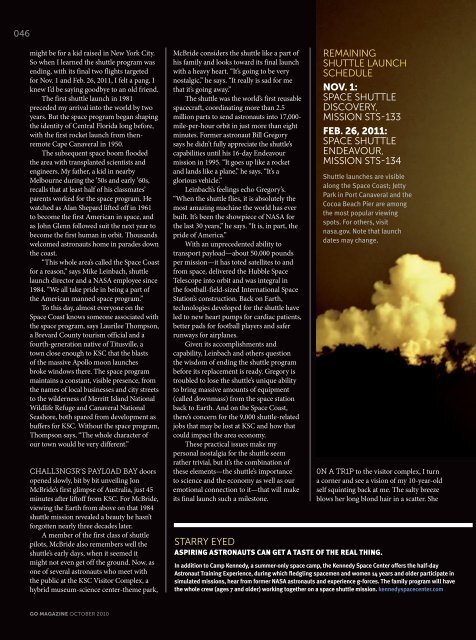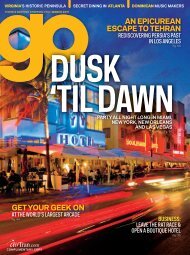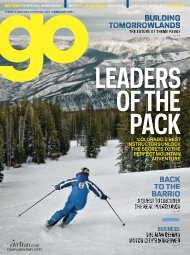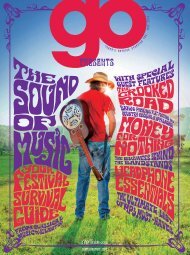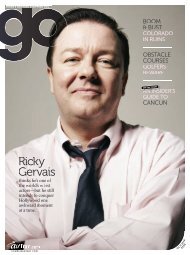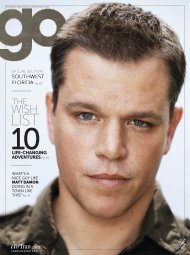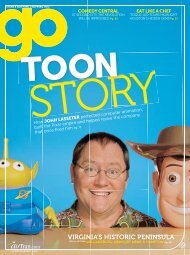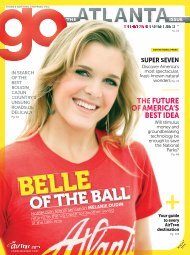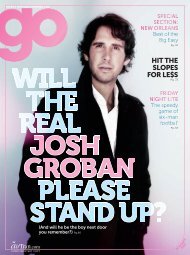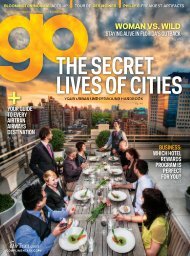You also want an ePaper? Increase the reach of your titles
YUMPU automatically turns print PDFs into web optimized ePapers that Google loves.
046<br />
might be for a kid raised in New York City.<br />
So when I learned the shuttle program was<br />
ending, with its final two flights targeted<br />
for Nov. 1 and Feb. 26, 2011, I felt a pang. I<br />
knew I’d be saying goodbye to an old friend.<br />
The first shuttle launch in 1981<br />
preceded my arrival into the world by two<br />
years. But the space program began shaping<br />
the identity of Central Florida long before,<br />
with the first rocket launch from thenremote<br />
Cape Canaveral in 1950.<br />
The subsequent space boom flooded<br />
the area with transplanted scientists and<br />
engineers. My father, a kid in nearby<br />
Melbourne during the ’50s and early ’60s,<br />
recalls that at least half of his classmates’<br />
parents worked for the space program. He<br />
watched as Alan Shepard lifted off in 1961<br />
to become the first American in space, and<br />
as John Glenn followed suit the next year to<br />
become the first human in orbit. Thousands<br />
welcomed astronauts home in parades down<br />
the coast.<br />
“This whole area’s called the Space Coast<br />
for a reason,” says Mike Leinbach, shuttle<br />
launch director and a NASA employee since<br />
1984. “We all take pride in being a part of<br />
the American manned space program.”<br />
To this day, almost everyone on the<br />
Space Coast knows someone associated with<br />
the space program, says Laurilee Thompson,<br />
a Brevard County tourism official and a<br />
fourth-generation native of Titusville, a<br />
town close enough to KSC that the blasts<br />
of the massive Apollo moon launches<br />
broke windows there. The space program<br />
maintains a constant, visible presence, from<br />
the names of local businesses and city streets<br />
to the wilderness of Merritt Island National<br />
Wildlife Refuge and Canaveral National<br />
Seashore, both spared from development as<br />
buffers for KSC. Without the space program,<br />
Thompson says, “The whole character of<br />
our town would be very different.”<br />
CHALL3NG3R’S PAYL0AD BAY doors<br />
opened slowly, bit by bit unveiling Jon<br />
McBride’s first glimpse of Australia, just 45<br />
minutes after liftoff from KSC. For McBride,<br />
viewing the Earth from above on that 1984<br />
shuttle mission revealed a beauty he hasn’t<br />
forgotten nearly three decades later.<br />
A member of the first class of shuttle<br />
pilots, McBride also remembers well the<br />
shuttle’s early days, when it seemed it<br />
might not even get off the ground. Now, as<br />
one of several astronauts who meet with<br />
the public at the KSC Visitor Complex, a<br />
hybrid museum-science center-theme park,<br />
GO MAGAZINE OCTOBER <strong>2010</strong><br />
McBride considers the shuttle like a part of<br />
his family and looks toward its final launch<br />
with a heavy heart. “It’s going to be very<br />
nostalgic,” he says. “It really is sad for me<br />
that it’s going away.”<br />
The shuttle was the world’s first reusable<br />
spacecraft, coordinating more than 2.5<br />
million parts to send astronauts into 17,000mile-per-hour<br />
orbit in just more than eight<br />
minutes. Former astronaut Bill Gregory<br />
says he didn’t fully appreciate the shuttle’s<br />
capabilities until his 16-day Endeavour<br />
mission in 1995. “It goes up like a rocket<br />
and lands like a plane,” he says. “It’s a<br />
glorious vehicle.”<br />
Leinbach’s feelings echo Gregory’s.<br />
“When the shuttle flies, it is absolutely the<br />
most amazing machine the world has ever<br />
built. It’s been the showpiece of NASA for<br />
the last 30 years,” he says. “It is, in part, the<br />
pride of America.”<br />
With an unprecedented ability to<br />
transport payload—about 50,000 pounds<br />
per mission—it has toted satellites to and<br />
from space, delivered the Hubble Space<br />
Telescope into orbit and was integral in<br />
the football-field-sized International Space<br />
Station’s construction. Back on Earth,<br />
technologies developed for the shuttle have<br />
led to new heart pumps for cardiac patients,<br />
better pads for football players and safer<br />
runways for airplanes.<br />
Given its accomplishments and<br />
capability, Leinbach and others question<br />
the wisdom of ending the shuttle program<br />
before its replacement is ready. Gregory is<br />
troubled to lose the shuttle’s unique ability<br />
to bring massive amounts of equipment<br />
(called downmass) from the space station<br />
back to Earth. And on the Space Coast,<br />
there’s concern for the 9,000 shuttle-related<br />
jobs that may be lost at KSC and how that<br />
could impact the area economy.<br />
These practical issues make my<br />
personal nostalgia for the shuttle seem<br />
rather trivial, but it’s the combination of<br />
these elements—the shuttle’s importance<br />
to science and the economy as well as our<br />
emotional connection to it—that will make<br />
its final launch such a milestone.<br />
REMAINING<br />
SHUTTLE LAUNCH<br />
SCHEDULE<br />
NOV. 1:<br />
SPACE SHUTTLE<br />
DISCOVERY,<br />
MISSION STS-133<br />
FEB. 26, 2011:<br />
SPACE SHUTTLE<br />
ENDEAVOUR,<br />
MISSION STS-134<br />
Shuttle launches are visible<br />
along the Space Coast; Jetty<br />
Park in Port Canaveral and the<br />
Cocoa Beach Pier are among<br />
the most popular viewing<br />
spots. For others, visit<br />
nasa.gov. Note that launch<br />
dates may change.<br />
0N A TR1P to the visitor complex, I turn<br />
a corner and see a vision of my 10-year-old<br />
self squinting back at me. The salty breeze<br />
blows her long blond hair in a scatter. She<br />
STARRY EYED<br />
ASPIRING ASTRONAUTS CAN GET A TASTE OF THE REAL THING.<br />
In addition to Camp Kennedy, a summer-only space camp, the Kennedy Space Center offers the half-day<br />
Astronaut Training Experience, during which fledgling spacemen and women 14 years and older participate in<br />
simulated missions, hear from former NASA astronauts and experience g-forces. The family program will have<br />
the whole crew (ages 7 and older) working together on a space shuttle mission. kennedyspacecenter.com


